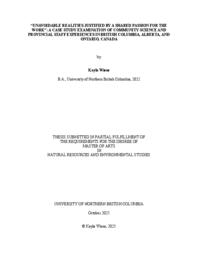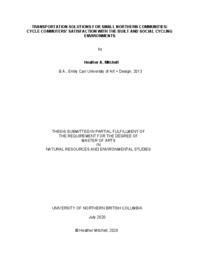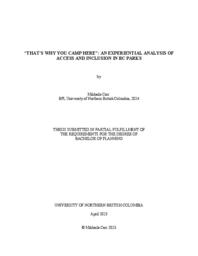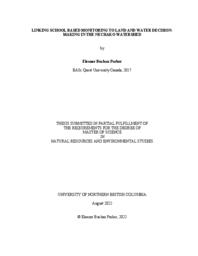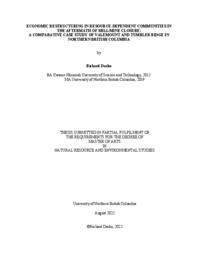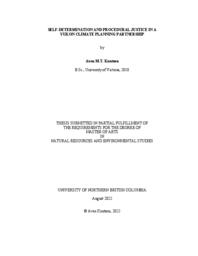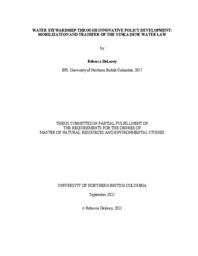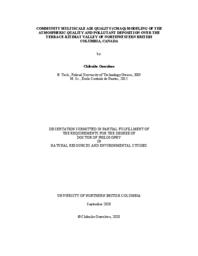Groulx, Mark
Person Preferred Name
Mark Groulx
Related Works
Content type
Digital Document
Origin Information
Content type
Digital Document
Origin Information
Content type
Digital Document
Origin Information
Content type
Digital Document
Description / Synopsis
It is well established in the literature that nature can provide a host of benefits to human health and wellbeing. However, access to outdoor recreation and nature-based tourism spaces remains inequitable, as park planning and management processes have not prioritized access and inclusion for all. Many studies have documented an overwhelming presence of physical, attitudinal, and informational barriers to accessing nature for persons with disability (PwD). These studies highlight an overwhelming presence of physical barriers and a lack of reliable and comprehensive accessibility information essential to enabling efficient trip planning processes. This research draws on the knowledge and lived experiences of a small group of people living with diverse impairments, in outdoor settings. Field observations utilizing a photovoice methodology and reflective journals were used to document interactions of PwD with (in)accessible nature spaces in two BC Parks regions. A thematic analysis of this data uncovered three emergent themes related to access and inclusion: the importance of access the key features, the availability of cognitive space to fully embody experiences, and information delivery on and off site. Findings from the project demonstrate how BC provincial parks might be experienced by individuals with a range of embodiments in nature. Place-based narratives using creative analytic practice weave the experiences of PwD in this research and objective standards data (e.g., measurements of infrastructure) to produce a diverse type of information that can enable trip planning processes for PwD.
Origin Information
Content type
Digital Document
Description / Synopsis
Climate change is compounding existing threats to waters from land use activities such as forestry, agriculture, and mining, requiring alternative approaches to caring for watersheds. Community science and school-based monitoring are gaining attention as processes for communities and youth to become involved in decision-making by collecting data about the health of their lands and waters. However, due to the complexity of social-ecological systems, connecting community science to decision-making is a recognized challenge requiring more qualitative research that engages various actors. In response, this action-research project aimed to co-design water monitoring tools with students, teachers, and decision-makers to explore potential avenues for school-based monitoring to inform decision-making. The project focused on the case study of the “Koh-learning in our Watersheds” education initiative on Saik’uz First Nation Territory near Vanderhoof, British Columbia. Research activities took place with high-school classes from the Nechako Valley Secondary School at locations along Murray Creek, a tributary to the Nechako River. Phases of water monitoring actively shaped and informed qualitative research interviews and workshops to bring together youth, teachers, and decision-makers. Pathways identified for school-based monitoring to inform decision-making include: 1) increased attention on waterways, 2) identifying issues and imagining solutions, 3) filling gaps and providing new data, 4) behaviour change and stewardship, 5) contributing to reconciliation, and 6) conversations for action. The findings highlight that the strengths of school-based monitoring lie in its ability to contribute imaginative solutions to local problems that perplex decisionmakers and, when attuned to and aligned with Indigenous governance, can meaningfully support truth and reconciliation. Informed by these findings, an adapted version of the framework for a ‘social learning approach to monitoring’ is proposed and may serve as a tool in the design of future school-based monitoring that can target multiple pathways to influence decision-making. This research underscores that when connecting across knowledges, generations, and linking with decision-making, school-based monitoring can support a paradigm shift in water management.
Origin Information
Content type
Digital Document
Description / Synopsis
Beyond the devastating effects on a community, deindustrialization can present an opportunity for change by highlighting the perilous effect of over-dependence on a single industry and motivating local stakeholders to enact change by building social capital and cohesion as well as engaging in local economic development. In small, historically resource-dependent communities, de-industrialization has shifted the focus from staples-based development to a more diverse economy rooted in place-based development. At the same time, the shift from FordistKeynesianism toward Post-Fordist Neoliberalism has limited companies’ obligations toward resource towns as they work through these transitions. Focusing on the case studies of Valemount and Tumbler Ridge, this thesis draws upon a comparative case study approach, key informant interviews, and analysis of documents for a deeper understanding of the processes, strategies, and outcomes regarding this transition. The thesis offers the following findings: First, the shift from a single industry to a diversified economy provides a clear case of a transition towards place-based development. Second, the emerging place-based development trajectory emphasizes the importance of local empowerment and management, strategic investments, social capital/cohesion, local capacity and planning, and government support in transitioning resource towns. Third, the shift from Fordist-Keynesianism to Post-Fordist Neoliberalism has resulted in retrenchment in corporate community development. Additionally, these findings support policy coordination to scale-up social and economic infrastructure, service support, and resources to help maintain place competitiveness and adaptability to future changes. Community transition must be restructured according to local context and needs. Integrating social impact mitigation into the existing BC Environmental Mitigation Policy and permitting process will help foster community sustainability and economic development.
Origin Information
Content type
Digital Document
Description / Synopsis
Planning for community resilience and climate change requires new forms of engagement that are accountable to Indigenous peoples and the social and cultural upheavals associated with colonial harm. This thesis shows that climate governance requires partnerships and policy actions that reflect needs and priorities of communities in specific geographic, political, and cultural contexts. As a case study, it examines the development of the 2020 Our Clean Future (OCF) strategy by Government of Yukon and Indigenous partners. Through semi-structured interviews and document studies, the research applies a theoretical lens of procedural justice and self-determination to the OCF process. Outcomes from this research offer a set of policy cycle considerations and recommendations for future environmental planning partnerships that include taking a rights-based approach, increasing capacity for collaboration in multiple areas, stronger integration of culturally diverse ways of knowing and doing, and targeted urban Indigenous engagement. Findings suggest OCF can serve as a useful procedural policy tool that supports Indigenous self-determination if lessons learned from the process are carried forward in future environmental planning partnerships.
Origin Information
Content type
Digital Document
Description / Synopsis
Policy mobility and transfer play a role in larger policy development and implementation processes, as actors look elsewhere for policy solutions to local issues. Conducted in collaboration with the Nadleh Whut’en First Nation and guided by an Indigenous methodology based on the Too Declaration with support from constructivist grounded theory, this research explores the mobilization and transfer of the Yinka Dene Water Law. Conversations with participants representing First Nations and interest groups reveal that the Water Law is being mobilized by individuals and groups at a variety of scales, and use varies from adoption and implementation, to inquiring about its transfer. This research also discusses factors influencing Water Law transfer, including shared policy problems and its function as a communication tool. There are few empirical examples of policy transfer processes between Indigenous contexts. This research contributes to filling this gap in the policy transfer literature by exploring such transfer between First Nations, and advances Nadleh Whut’en’s stewardship and implementation related objectives.
Origin Information
Content type
Digital Document
Description / Synopsis
Tracking the effects of air pollution from industries is important for developing management strategies under changing emissions. However, computational tools for air pollution assessment often do not elucidate modeling uncertainty, making it difficult for environmental policy-makers to know how much confidence to put in model results, which also hampers aspects that may need improving. This study examined how the WRF-SMOKE-CMAQ modeling system with various planetary boundary-layer (PBL) schemes and atmospheric datasets mimics the local meteorology, air quality and acidic deposition at 1 km horizontal resolution over the industrializing Terrace-Kitimat Valley of northwestern British Columbia. Quantitative and qualitative correspondence of model outputs with observational data varied with station location, the nature of pollutant emissions, and quantity of chemical species. Valid model outputs were used to delineate present compliance with objectives on ambient fine particulate matter, and baseline exceedance of critical loads of sulfur and nitrogen deposition for the forest ecosystem. Spatial impacts of anticipated industrial emissions on the environment were also assessed. An additional 15 tonnes day-1 permissible SO2 emission from an aluminum smelter in Kitimat was projected to result in 50–88 % increase in aerial exceedance of the limit for protection of lichen, and 37–67 % increase in spatial exceedance of acidic deposition to soils. Cumulatively, 16–18 km2 of plant habitat, and 10–11 km2 of soil in an area contiguous with the smelter site will likely be damaged by its SO2 emission under the latest regulation. Should two Liquefied Natural Gas projects commence operations, cumulative NOx concentrations are expected to remain below harmful levels, while pre-existing areal exceedance of nitrogen deposition will barely increase (0–1 km2). An additional 4 km2 area will be exposed to SO2 concentrationsiii that are directly harmful to vegetation, while 13–14 km2 total area with an average of 29.7–35.0 kg ha-1 yr-1 excess sulfur deposition was estimated. These projections assumed all future emissions of NOx, SO2 and other air pollutants will be from elevated point sources.
Origin Information

